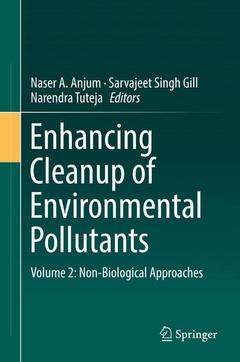Description
Enhancing Cleanup of Environmental Pollutants, 1st ed. 2017
Volume 2: Non-Biological Approaches
Language: English
Subjects for Enhancing Cleanup of Environmental Pollutants:
Keywords
pesticide contaminated soils; PAH polluted soils; phytoremediation; mineralization of organic contaminants; mine tailings; fly ash dump sites; petroleum hydrocrabons; Plant Growth Promoting Rhizobacteria; biosorption and bioaccumulation; organic micropollutants; mycorrhizas; terrestrial pollution
Enhancing Cleanup of Environmental Pollutants
Publication date: 05-2017
Support: Print on demand
Publication date: 05-2017
Support: Print on demand
Enhancing Cleanup of Environmental Pollutants
Publication date: 07-2018
Support: Print on demand
Publication date: 07-2018
Support: Print on demand
Description
/li>Contents
/li>Biography
/li>Comment
/li>
This two-volume work is an effort to provide a common platform to environmental engineers, microbiologists, chemical scientists, plant physiologists and molecular biologists working with a common aim of sustainable solutions to varied environmental contamination issues. Chapters explore biological and non-biological strategies to minimize environmental pollution. Highly readable entries attempt to close the knowledge gap between plant - microbial associations and environmental remediation.
Volume 2 focuses on the non-biological/chemical approaches for the cleanup of contaminated soils. Important concepts such as the role of metallic iron in the decontamination of hexavalent chromium polluted waters are highlighted; in addition, nanoscale materials and electrochemical approaches used in water and soil remediation are discussed; and the synthesis and characterization of cation composite exchange material and its application in removing toxic metals are elaborated in detail. Readers will also discover the major advances in the remediation of environmental pollutants by adsorption technologies.
Chapter 1. Enhancing the cleanup of environmental pollutants and the role of abiological approaches: an introduction.- Chapter 2. Electrochemical technologies for environmental remediation.- Chapter 3. Microwave heating-mediated remediation of hydrocarbon-polluted soils: theoretical background and techno-economic considerations.- Chapter 4. Arsenic behaviour in soil-plant system: biogeochemical reactions and chemical speciation influences.- Chapter 5. Pollutants decontamination from water: role of nano-composite materials.- Chapter 6. Textile wastewater treatment options: a critical review.- Chapter 7. Decontamination of hexavalent chromium polluted waters: significance of metallic iron.- Chapter 8. Dual functional styrene-maleic acid copolymer beads: toxic metals adsorbent and hydrogen storage.- Chapter 9. Synthesis and characterization of cation composite exchange material and its application in removing toxic pollutants.- Chapter 10. Remediation of soils polluted with inorganic contaminants: role of organic amendments.- Chapter 11. Enhancing decontamination of PAHs-polluted soils: role of organic and mineral amendments.
Naser A. Anjum is a researcher at CESAM-Centre for Environmental and Marine Studies & Department of Chemistry, University of Aveiro, Portugal.
Dr. Sarvajeet S. Gill is an Assistant Professor at the Centre for Biotechnology, Maharshi Dayanand University in Haryana, India.
Dr. Narendra Tuteja is a Professor and Director of Amity Institute of Microbial Technology (AIMT), Amity University in Uttar Pradesh, India.
Demonstrates the role of plants and microbes in improving soil fertility and function Assists members of the environmental and plant sciences community to keep abreast of developments in terrestrial pollutant minimization Summarizes key recent research on non-biological approaches employed for cleanup of polluted soils Includes supplementary material: sn.pub/extras
© 2024 LAVOISIER S.A.S.




